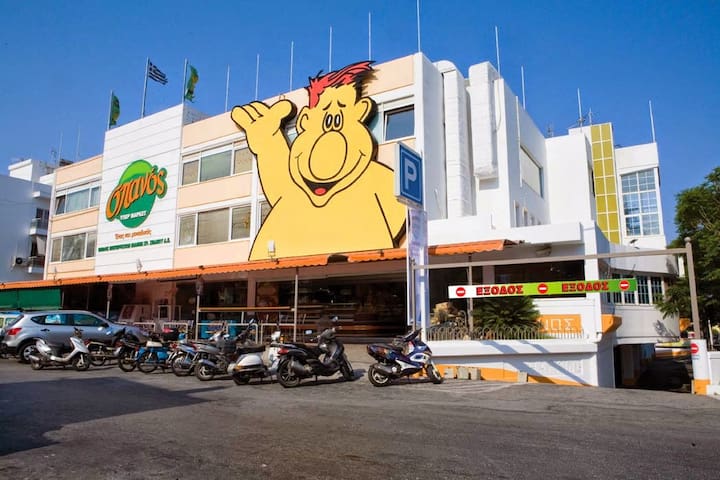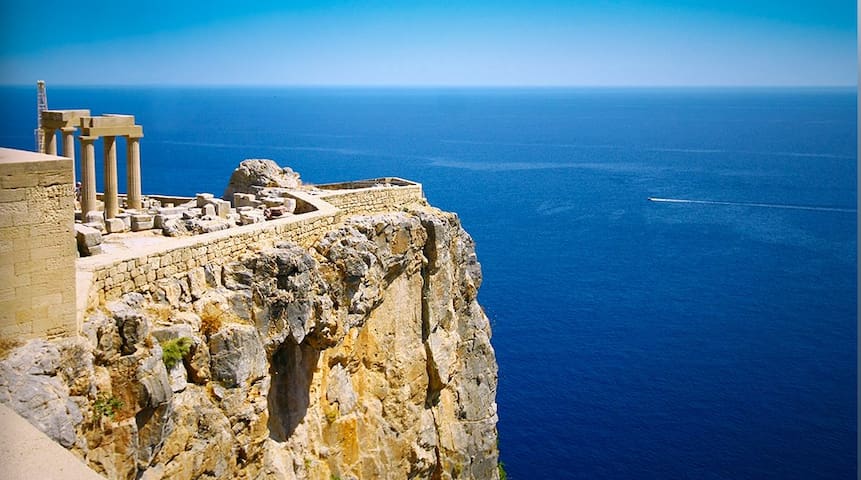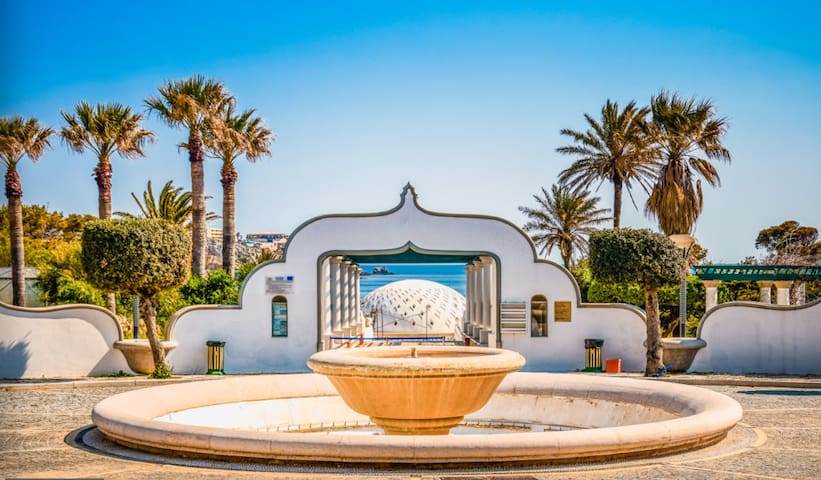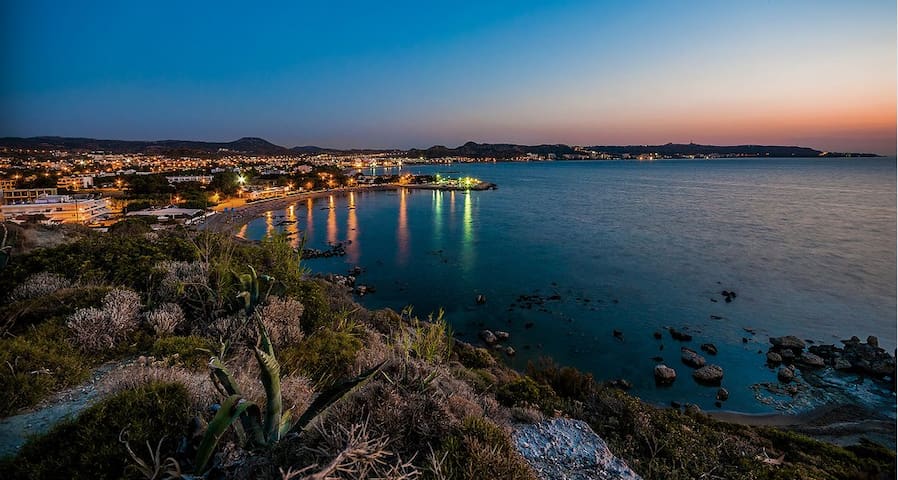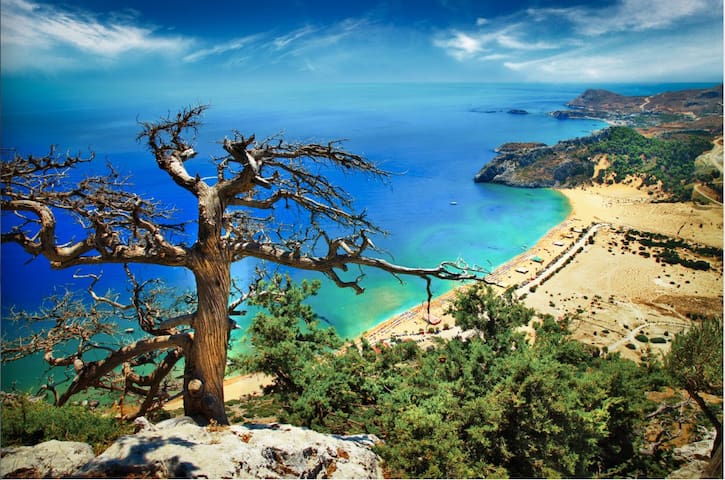Places to eat near the property (in less than 5 min)
LEVENTIS PIZZA RESTAURANT
28 Eth. AntistasisTakisTaste
67 Eth. AntistasisBest coffee on the island with dozens of flavors! Great for breakfast!
6 Einheimische empfehlen
Coffee Island
39 Eth. AntistasisBest coffee on the island with dozens of flavors! Great for breakfast!
SuperMarkets Spanos
Il Massimo
11 Kon/nou PaleologouSoul kitchen
34 LemesouGreek authentic, inexpensive restaurant run by a family with traditional recipes.
26 Einheimische empfehlen
To steno
29 Ag. AnargironGreek authentic, inexpensive restaurant run by a family with traditional recipes.
Top archeological sites in Rhodes
Archäologisches Museum von Rhodos (Hospital der Ritter)
8 Akti SachtouriArchaeological site
IsiodouGroßmeisterpalast
IppotonThe Acropolis of Rhodes dating from the Classical Greek period (5th–3rd century BC) is just a 15 min walk from the property. The site consists of the Temple of Apollo (also, as alternatives Athena Polias and Zeus Polieus) below which is a stadium and a small Odeon where musical activities such as singing, musical shows, and poetry competitions were held. Odeons were smaller than Greek and Roman theaters.
All is included in a large park called Monte Smith, named after an English Napoleonic admiral William Sidney Smith.
65 Einheimische empfehlen
Acropolis of Rhodes
68 DiagoridonThe Acropolis of Rhodes dating from the Classical Greek period (5th–3rd century BC) is just a 15 min walk from the property. The site consists of the Temple of Apollo (also, as alternatives Athena Polias and Zeus Polieus) below which is a stadium and a small Odeon where musical activities such as singing, musical shows, and poetry competitions were held. Odeons were smaller than Greek and Roman theaters.
All is included in a large park called Monte Smith, named after an English Napoleonic admiral William Sidney Smith.
Beaches in Rhodes Town
Elli Strand
6 Pl. KountouriotiZephyros beach
127 Klavdiou PeperAkti Miaouli
Akti MiaouliSuperMarkets near the property (in less than 5 min)
My market
SuperMarkets Spanos
Famous Places to reach with the bus (Bus-stop only 2 minutes from property)
This is the most impressive archaeological site on the island of Rhodes, where the dramatic natural landscape is enhanced by the picturesque quality of the more modern town. The most important archaeological monuments are to be found at the Acropolis, but there are also interesting ruins scattered at various points within the town and just outside it.
A cobbled road leads up to the Acropolis, and for those who wish to avoid the tiring climb there are donkeys for hire at the main entrance to the town. The first ruins you will encounter are the mediaeval walls, built by the Crusaders (early 14th century) on the remains of earlier defenses, both Byzantine and ancient. Along the mediaeval walls are a very small number of towers, which follow the natural contours of the high ground. On the area of level ground where the mediaeval steps begin you will see to your left an ancient triimolia (a kind of ship) carved in the rock circa 180-170 B.C.
On the ship’s prow there once stood a statue of the general Agisandros Mikkion (it has not survived) which, according to the inscription, was the work of Pythokritos, creator of the Nike of Samothrace. The great mediaeval steps lead up to the Governors Palace of the Crusader castle, which consisted of three buildings, of which two have survived. It was first restored in the early 20th century by the Danish Archaeological Mission and then, during the period between the world wars, by the Italian authorities. As you come out of the Governor’s Palace you will see a series of vaulted constructions supporting the “andiro”, a man-made terrace which opens out in front of the Hellenistic stoa. A number of the columns are still standing.
It was built in the shape of the Greek letter fl, in the late 3rd century BC, with protruding wings to the side, each with a frontage of four columns. It was 88 m. long, 9 m. wide and had 42 columns. The terrace was laid out later and two underground cisterns were also constructed to collect rainwater from the roof of the stoa and from the steps of the Propylaea. The scattered plinths with their inscriptions remind us of the time when the whole area was full of statues dedicated to the goddess. Next to the Governor’s Palace stands the church of Agios loannis, built on the inscribed cruciform plan. It is not clear precisely when it was built; some assign it to the late 11th – early 12th century, others to the 13th – 14th century. It was constructed on the remains of an earlier church, judging from the architectural fragments found on the Acropolis and dating from the 6th century AD.
A monumental flight of steps, behind the eight central columns of the Hellenistic stoa, leads up to the Propylaea of the temple of Undia Athena, another stoa structure in the same shape. Only the foundations have survived. At the two ends of the Propylaea there were areas where the votive offerings made to the goddess were stored. The stoa was built of porous stone at the end of the 4th century B.C. At the highest point of the Acropolis, on the edge of the cliff, stands the temple of Lindia Athena. This is an unexpectedly small Doric temple, with a stoa of four columns at each end. There still remain in the interior the votive altar and the plinth of the worshiped statue of the goddess. This building too was of porous stone, with mortar facing, and dates from the end of the 4th century B.C. (Open daily, 8.30am-2.40pm in the winter, 8am-7pm in the summer).
60 Einheimische empfehlen
Acropolis of Lindos
This is the most impressive archaeological site on the island of Rhodes, where the dramatic natural landscape is enhanced by the picturesque quality of the more modern town. The most important archaeological monuments are to be found at the Acropolis, but there are also interesting ruins scattered at various points within the town and just outside it.
A cobbled road leads up to the Acropolis, and for those who wish to avoid the tiring climb there are donkeys for hire at the main entrance to the town. The first ruins you will encounter are the mediaeval walls, built by the Crusaders (early 14th century) on the remains of earlier defenses, both Byzantine and ancient. Along the mediaeval walls are a very small number of towers, which follow the natural contours of the high ground. On the area of level ground where the mediaeval steps begin you will see to your left an ancient triimolia (a kind of ship) carved in the rock circa 180-170 B.C.
On the ship’s prow there once stood a statue of the general Agisandros Mikkion (it has not survived) which, according to the inscription, was the work of Pythokritos, creator of the Nike of Samothrace. The great mediaeval steps lead up to the Governors Palace of the Crusader castle, which consisted of three buildings, of which two have survived. It was first restored in the early 20th century by the Danish Archaeological Mission and then, during the period between the world wars, by the Italian authorities. As you come out of the Governor’s Palace you will see a series of vaulted constructions supporting the “andiro”, a man-made terrace which opens out in front of the Hellenistic stoa. A number of the columns are still standing.
It was built in the shape of the Greek letter fl, in the late 3rd century BC, with protruding wings to the side, each with a frontage of four columns. It was 88 m. long, 9 m. wide and had 42 columns. The terrace was laid out later and two underground cisterns were also constructed to collect rainwater from the roof of the stoa and from the steps of the Propylaea. The scattered plinths with their inscriptions remind us of the time when the whole area was full of statues dedicated to the goddess. Next to the Governor’s Palace stands the church of Agios loannis, built on the inscribed cruciform plan. It is not clear precisely when it was built; some assign it to the late 11th – early 12th century, others to the 13th – 14th century. It was constructed on the remains of an earlier church, judging from the architectural fragments found on the Acropolis and dating from the 6th century AD.
A monumental flight of steps, behind the eight central columns of the Hellenistic stoa, leads up to the Propylaea of the temple of Undia Athena, another stoa structure in the same shape. Only the foundations have survived. At the two ends of the Propylaea there were areas where the votive offerings made to the goddess were stored. The stoa was built of porous stone at the end of the 4th century B.C. At the highest point of the Acropolis, on the edge of the cliff, stands the temple of Lindia Athena. This is an unexpectedly small Doric temple, with a stoa of four columns at each end. There still remain in the interior the votive altar and the plinth of the worshiped statue of the goddess. This building too was of porous stone, with mortar facing, and dates from the end of the 4th century B.C. (Open daily, 8.30am-2.40pm in the winter, 8am-7pm in the summer).
Since the antiquity, the area of Kalithea (Καλλιθέα) was famous for its thermal, therapeutic springs. Located in the north-eastern part of the island of Rhodos, on the coastal road to Faliraki, it is distant just 7km from the capital city and is accessible by public transportation. A very popular place among the locals and the tourists, Kalithea is scattered by numerous coves and bays, each one with its particular character. Umbrellas and sun beds are almost everywhere, some even on the rocks sculptured out by the sea.
The most important feature of Kalithea are undoubtedly, the sparkling white buildings of the Thermal Baths. Constructed during the late ’30s, under the Italian rule of the island, they represent a glaring example of the Spa architecture mixed with the particular colonial style developed in Rhodes. Masterfully combining different architectural influences from Arabic to Baroque, the architect Pietro Lombardi -who has also constructed the European Parliament building in Strasbourg-, creates an architectural composition considered among the best of the time. Although the springs are no longer in operation this fabulous building is considered a distinguished Cultural Monument. Surrounded by palms and pine trees, the main building is used as a venue for weddings and other important events while other buildings have been converted to dinning and cafe facilities.
The main beach has a stretch of sand. The emerald waters of the sea match perfectly with this idyllic scenery, adding one more touch of beauty to the whole picture.
117 Einheimische empfehlen
Kallithea-Quellen
80 Leof. KallitheasSince the antiquity, the area of Kalithea (Καλλιθέα) was famous for its thermal, therapeutic springs. Located in the north-eastern part of the island of Rhodos, on the coastal road to Faliraki, it is distant just 7km from the capital city and is accessible by public transportation. A very popular place among the locals and the tourists, Kalithea is scattered by numerous coves and bays, each one with its particular character. Umbrellas and sun beds are almost everywhere, some even on the rocks sculptured out by the sea.
The most important feature of Kalithea are undoubtedly, the sparkling white buildings of the Thermal Baths. Constructed during the late ’30s, under the Italian rule of the island, they represent a glaring example of the Spa architecture mixed with the particular colonial style developed in Rhodes. Masterfully combining different architectural influences from Arabic to Baroque, the architect Pietro Lombardi -who has also constructed the European Parliament building in Strasbourg-, creates an architectural composition considered among the best of the time. Although the springs are no longer in operation this fabulous building is considered a distinguished Cultural Monument. Surrounded by palms and pine trees, the main building is used as a venue for weddings and other important events while other buildings have been converted to dinning and cafe facilities.
The main beach has a stretch of sand. The emerald waters of the sea match perfectly with this idyllic scenery, adding one more touch of beauty to the whole picture.
Situated on the east coast of Rhodes, at about 14 km south of the capital, Faliraki is one of the island’s most developed beach resorts, renowned for its almost 4 km long stretch of wonderful sandy beach and its active nightlife. There is a constant development and transformation in Faliraki in the recent years as a new epicenter, targeted to family oriented beach based holidays, is been created to the northern part of the bay with new hotels and shopping centers with one of Europe’s biggest and best water parks, offering slides, lazy river rides, rafting, a wave pool, aqua-gym and numerous other thrills and spills.
It is possible to do day boat trips around the other small bays of Faliraki, including Kathara Bay, which is one of the most picturesque on the island, and has a nudist beach at one end. Anthony Quinn Bay is famous for the filming of The Guns of Navarone. There are also several, less developed beaches between Faliraki and Lindos, such as the pebbled Traganou beach, and all the beaches are desirably clean with crystal waters.
29 Einheimische empfehlen
Faliraki A
ErmoiSituated on the east coast of Rhodes, at about 14 km south of the capital, Faliraki is one of the island’s most developed beach resorts, renowned for its almost 4 km long stretch of wonderful sandy beach and its active nightlife. There is a constant development and transformation in Faliraki in the recent years as a new epicenter, targeted to family oriented beach based holidays, is been created to the northern part of the bay with new hotels and shopping centers with one of Europe’s biggest and best water parks, offering slides, lazy river rides, rafting, a wave pool, aqua-gym and numerous other thrills and spills.
It is possible to do day boat trips around the other small bays of Faliraki, including Kathara Bay, which is one of the most picturesque on the island, and has a nudist beach at one end. Anthony Quinn Bay is famous for the filming of The Guns of Navarone. There are also several, less developed beaches between Faliraki and Lindos, such as the pebbled Traganou beach, and all the beaches are desirably clean with crystal waters.
Tsambika is an 800 meters long beach of fine pure gold sand, gently shelving on the east coast of the island of Rhodos. Distant at about 26 km from the capital, this exotic looking beach has survived from permanent development as most of the land is owned by the Orthodox Church. In fact, at the north end of the beach, on a sharp peak overlooking the beach, there is the church of Panagià Tsambika.
It is very easy to access. After a short nice drive down off the main road you get to a long stretch of parking space just by the beach.
Tsambika is considered as one of the best beaches on the island. It has crystal clear waters and it’s considered ideal for families with children as it is all sandy and shallow. There is a tranquil naturist section at the far end of the beach for a safe natural swim.
Lots of facilities on the beach. Beach bars, umbrellas and loungers, watersports and a few canteens for sandwiches, ice cream and refreshments. There are also a few nice traditional tavernas on the road down to the beach.
Tsambika can be reached by public transport but it is better to get there by car or bike as there are a lot of interesting surroundings to explore.
99 Einheimische empfehlen
Tsambika Beach
Tsambika is an 800 meters long beach of fine pure gold sand, gently shelving on the east coast of the island of Rhodos. Distant at about 26 km from the capital, this exotic looking beach has survived from permanent development as most of the land is owned by the Orthodox Church. In fact, at the north end of the beach, on a sharp peak overlooking the beach, there is the church of Panagià Tsambika.
It is very easy to access. After a short nice drive down off the main road you get to a long stretch of parking space just by the beach.
Tsambika is considered as one of the best beaches on the island. It has crystal clear waters and it’s considered ideal for families with children as it is all sandy and shallow. There is a tranquil naturist section at the far end of the beach for a safe natural swim.
Lots of facilities on the beach. Beach bars, umbrellas and loungers, watersports and a few canteens for sandwiches, ice cream and refreshments. There are also a few nice traditional tavernas on the road down to the beach.
Tsambika can be reached by public transport but it is better to get there by car or bike as there are a lot of interesting surroundings to explore.
Sightseeing (Must See)
Rodini Park was probably the first landscaped park in the world. It was still popular with the Romans some years later and they left a bit of an aqueduct here.
The park has been arranged along a natural stream. This is an ideal environment for the peacocks which live and breed freely in the park. It's a pleasure to come here, to get a respite from the heat of the day. Enjoy the cool walkway leading along the bank of the stream.
Rodini Park is rich in flora, with perennial plane trees, oleanders, high-sky pines, springs with water gushing through the rocks. It offers areas for relaxation, a playground, park benches and provides its guests a feeling of peace and tranquility.
A walk of about 10 minutes will bring you to a tomb carved into the rock. The tomb, dating from the Hellenist period and featuring a decoration of 21 Doric half-pillars - is known as the tomb of the Ptolemies.
The tomb of the Ptolemies is an important, probably 2nd century BC, Hellenistic funerary monument with a pediment ed doorway and stuccoed façade. This is in effect an outcrop of natural rock fashioned into a 30m square block. Its north side has been dressed with a row of carved, engaged pilasters which have been plastered and were once colored, and which stand as if on a stepped crepis.
53 Einheimische empfehlen
Rodini-Park
Lindou Rodini Park was probably the first landscaped park in the world. It was still popular with the Romans some years later and they left a bit of an aqueduct here.
The park has been arranged along a natural stream. This is an ideal environment for the peacocks which live and breed freely in the park. It's a pleasure to come here, to get a respite from the heat of the day. Enjoy the cool walkway leading along the bank of the stream.
Rodini Park is rich in flora, with perennial plane trees, oleanders, high-sky pines, springs with water gushing through the rocks. It offers areas for relaxation, a playground, park benches and provides its guests a feeling of peace and tranquility.
A walk of about 10 minutes will bring you to a tomb carved into the rock. The tomb, dating from the Hellenist period and featuring a decoration of 21 Doric half-pillars - is known as the tomb of the Ptolemies.
The tomb of the Ptolemies is an important, probably 2nd century BC, Hellenistic funerary monument with a pediment ed doorway and stuccoed façade. This is in effect an outcrop of natural rock fashioned into a 30m square block. Its north side has been dressed with a row of carved, engaged pilasters which have been plastered and were once colored, and which stand as if on a stepped crepis.
Old Town of Rhodes (UNESCO World Cultural Heritage)
Rhodes Old Medieval Town is only a 7 min walk from property!
When you approach the walls of Medieval Old Town of Rhodes you are about to enter the oldest inhabited medieval city in Europe. It's a thrill to behold. Best to know one thing from the start about the Old Town of Rhodes: It's not laid out on a grid - not even close.
In the Medieval - Old - Town of Rhodes one may for sure enjoy one of the most interesting walks on the island. Do not let the "medieval" mislead you: rather than a ruined, deserted setting, you will be pleasantly surprised to wander through an intricate network of busy little commercial streets delightfully alternating with quiet alleys, in what is a very much alive town consistently dwelt in over the last two thousand years! No wonder, therefore, that for some time now, the Medieval Quarter of Rhodes - the oldest inhabited medieval town in Europe - forms part of the UNESCO World Cultural Heritage network!
This is a bustling neighborhood of some 6000 people, who live and work in the same buildings in which the Knights of St. John dwelt, six centuries ago. An emotion certain to remain forever alive on one’s memory!
Medieval buildings, mosques, traditional fountains, oriental motifs, Byzantine and Gothic churches, shops and cafeterias are scattered throughout the Old Town of Rhodes, all blending together to create a unique and picturesque whole. There are roughly 200 streets or alleys - some of them bearing no name! Getting “lost” here is not a defeat; it's an opportunity. Whenever you feel the need to find your bearings, you may ask for "Sokratous" street, which is the closest the Medieval City comes to having a main street.
The highlights - what to see in the Old Town of Rhodes
The Palace of the Grand Master, reinstated by the Italians in 1940 after almost a century of abandonment (the building had been destroyed as a result of an explosion in a forgotten powder store in its basement, in 1856), stands out because of its imposing entrance and exquisitely well-preserved towers and battlements. The interiors of the buildings, decorated with priceless ornamental objects, are equally impressive.
The Archaeological Museum is housed in the Gothic building of the Great Hospital of the Knights and preserves masterpieces of art on Rhodes, finds from ancient lalysos and Kamiros and mosaic paintings from the city of Rhodes.
The Knight's Street, the imposing street that leads to the Palace of the Grand Master, keeps alive the accommodations of the "language" of the Order of Knights.
It is worth visiting the Panagia tou Kastrou, the Panagia tou Bourgkou, the Clock-Tower, the synagogue and the mosques of the Suleiman and Recep Pasha.
The medieval city of Rhodes is one of the few remaining medieval cities in the world that is still inhabited and alive.
45 Einheimische empfehlen
Rhodes
Rhodes Old Medieval Town is only a 7 min walk from property!
When you approach the walls of Medieval Old Town of Rhodes you are about to enter the oldest inhabited medieval city in Europe. It's a thrill to behold. Best to know one thing from the start about the Old Town of Rhodes: It's not laid out on a grid - not even close.
In the Medieval - Old - Town of Rhodes one may for sure enjoy one of the most interesting walks on the island. Do not let the "medieval" mislead you: rather than a ruined, deserted setting, you will be pleasantly surprised to wander through an intricate network of busy little commercial streets delightfully alternating with quiet alleys, in what is a very much alive town consistently dwelt in over the last two thousand years! No wonder, therefore, that for some time now, the Medieval Quarter of Rhodes - the oldest inhabited medieval town in Europe - forms part of the UNESCO World Cultural Heritage network!
This is a bustling neighborhood of some 6000 people, who live and work in the same buildings in which the Knights of St. John dwelt, six centuries ago. An emotion certain to remain forever alive on one’s memory!
Medieval buildings, mosques, traditional fountains, oriental motifs, Byzantine and Gothic churches, shops and cafeterias are scattered throughout the Old Town of Rhodes, all blending together to create a unique and picturesque whole. There are roughly 200 streets or alleys - some of them bearing no name! Getting “lost” here is not a defeat; it's an opportunity. Whenever you feel the need to find your bearings, you may ask for "Sokratous" street, which is the closest the Medieval City comes to having a main street.
The highlights - what to see in the Old Town of Rhodes
The Palace of the Grand Master, reinstated by the Italians in 1940 after almost a century of abandonment (the building had been destroyed as a result of an explosion in a forgotten powder store in its basement, in 1856), stands out because of its imposing entrance and exquisitely well-preserved towers and battlements. The interiors of the buildings, decorated with priceless ornamental objects, are equally impressive.
The Archaeological Museum is housed in the Gothic building of the Great Hospital of the Knights and preserves masterpieces of art on Rhodes, finds from ancient lalysos and Kamiros and mosaic paintings from the city of Rhodes.
The Knight's Street, the imposing street that leads to the Palace of the Grand Master, keeps alive the accommodations of the "language" of the Order of Knights.
It is worth visiting the Panagia tou Kastrou, the Panagia tou Bourgkou, the Clock-Tower, the synagogue and the mosques of the Suleiman and Recep Pasha.
The medieval city of Rhodes is one of the few remaining medieval cities in the world that is still inhabited and alive.




